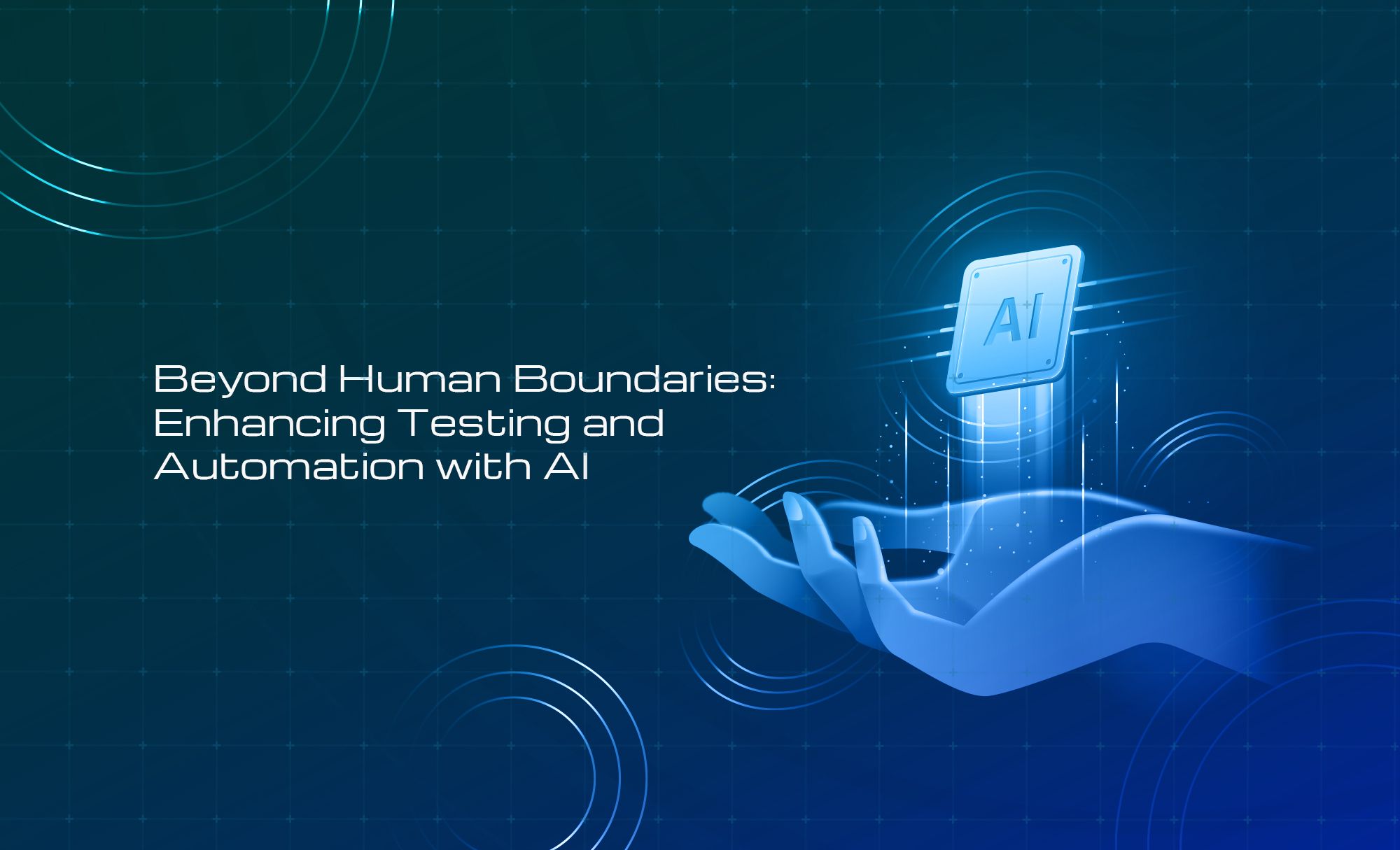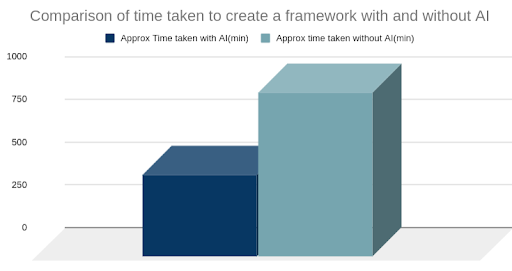
Highlights
- AI testing is reshaping software automation with smarter, faster, and more reliable quality checks.
- Tools like ChatGPT, Bing Chat, and GitHub Copilot help testers automate scripts, debug faster, and enhance accuracy.
- Real-world results show that AI-driven automation can cut testing time and boost efficiency across industries.
Why embrace the AI-powered revolution in software testing?
The software industry is advancing at a rapid pace, with an ever-growing demand for faster, smarter, and error-free applications. To ensure the quality and reliability of these products, software testing and automation play a crucial role.
Today, AI testing marks a new era—where AI in testing empowers engineers with intelligent capabilities to optimize workflows, reduce manual effort, and expand test coverage.
By embracing AI tools for software testing, teams can shift their focus from repetitive tasks to innovation. In this blog, we’ll explore three powerful AI-driven tools, such as ChatGPT, Bing Chat, and GitHub Copilot, and how they are redefining AI in software test automation.
With the rise of these technologies, testing is no longer just about scripts and test cases; it’s about creating self-learning, adaptive systems that predict, test, and improve continuously. Let’s see how these tools are shaping the future of intelligent automation.
How do modern AI tools like ChatGPT, Bing Chat, and GitHub Copilot redefine AI testing?
1. ChatGPT — Smarter test generation and scenario design
Harnessing the power of OpenAI’s GPT technology, ChatGPT is transforming how testers generate test cases and simulate real-world user interactions.
Instead of manually drafting test scenarios, QA teams can now use ChatGPT to create context-aware test scripts, brainstorm edge cases, and even validate expected outcomes—all in plain English.
This not only improves test coverage but also brings AI in testing closer to real human logic.
2. Bing Chat — Intelligent interface and UX testing
Developed by Microsoft, Bing Chat is proving valuable in UI and UX validation. Testers can simulate user interactions, verify navigation flows, and even check how systems respond under different conversational prompts.
By integrating AI in software test automation, Bing Chat helps identify usability issues early, improving both accuracy and user experience before release.
3. GitHub Copilot — Accelerating automation through AI
In collaboration with OpenAI, GitHub Copilot acts as an AI-powered coding assistant that suggests and completes lines of test code in real time.
From writing test scripts and environment setup code to handling repetitive automation tasks, Copilot allows testers to work faster and with fewer errors.
Among the best AI automation testing tools available today, it seamlessly bridges development and QA workflows—making automation smarter and more efficient.
How is AI-driven automation reshaping the future of software testing?
Our exploration of AI testing goes beyond tools and touches every layer of automation—from API to web and mobile testing.As AI matures, it’s no longer just an assistant; it’s a strategic partner helping QA teams predict failures, prioritize tests, and accelerate releases.Let’s take a closer look at how AI-driven automation is improving API testing and making test environments smarter and more reliable.
How is AI improving API automation and test reliability?
API automation forms the backbone of modern software testing, enabling faster validation of integrations and system behavior.However, traditional API testing often struggles with complexity, data dependencies, and inconsistent environments.This is where AI-powered tools like ChatGPT and GitHub Copilot are stepping in — not to replace testers, but to make the process smarter and more efficient.
Below is a quick look at how AI simplifies common API testing challenges.
| Challenges in API automation | AI-powered solutions | |
|---|---|---|
| Complexity | Modern APIs often come with hundreds of endpoints and nested data structures, making manual test setup time-consuming. | AI tools for software testing, such as ChatGPT and GitHub Copilot, can now auto-generate test scripts, boilerplate code, and even mock API calls — saving hours of effort. |
| Data dependencies | Managing data dependencies (when one API’s output feeds another) can lead to unstable tests if not handled well. | Models like GPT can suggest validation logic, automatically handle dependency mapping, and generate resilient test data flows. |
| Environment setup | A consistent, production-like environment is vital for accuracy but tricky to replicate. | Tools like GitHub Copilot assist by generating setup code templates and configuration scripts. While manual validation is still needed, AI in software test automation drastically reduces setup time. |
Case study: How AI testing redefined efficiency for a payment platform
When a leading mobile payment services provider set out to scale their API automation, their biggest challenge was speed and reliability. Manual test setup and maintenance were slowing releases, and the team wanted to see how AI-driven tools could change the game.
Phase 1: Setting up with the right framework
Since the QA team was proficient in Java, they turned to ChatGPT for guidance on the ideal framework. The recommendation was TestNG with RestAssured, a powerful combination for API test automation. Using ChatGPT’s prompt-based suggestions, the team quickly created a clean folder structure and built the foundation for the project.
Phase 2: Building the core automation layer
For the BaseTest setup and teardown logic, Bing Chat provided clear, ready-to-use code snippets. When the team needed a reporting tool that integrated seamlessly, Bing Chat suggested Allure and Extent Reports. They chose Allure, following ChatGPT’s detailed integration steps that included the use of the allure.properties configuration file. ChatGPT also helped with adding retry logic through RetryAnalyzer and generating all TestNG listeners required for the framework.
Phase 3: Coding made faster with GitHub Copilot
With GitHub Copilot, repetitive coding tasks such as creating constant files and configuring environments became much faster. Copilot also assisted by suggesting API validation techniques, improving accuracy, and minimizing manual effort.
Phase 4: Debugging and fine-tuning
During debugging, Bing Chat delivered accurate, context-aware responses that helped identify and fix issues within minutes. The team used precise prompts to troubleshoot efficiently, cutting down debugging time significantly.
Results: Efficiency visualized
By integrating AI in testing workflows, the team achieved a notable reduction in total testing time. The time comparison chart below highlights the performance difference between traditional testing and AI in software test automation, clearly showing the improvement in both speed and consistency.


Overall, the project demonstrated that AI-powered testing can enhance productivity and streamline complex automation pipelines.
Ready to explore how AI testing can transform your product development? Let’s build intelligent, automated systems that scale with precision and speed. Connect with us now!
The future of AI testing and automation
The next phase of AI in testing is about more than speed or accuracy. It is about intelligence that learns and adapts. Testing tools are beginning to predict failures, prioritize critical paths, and even suggest fixes before an issue reaches production.
In the near future, we will see self-healing test scripts, AI-driven reporting dashboards, and continuous validation systems that evolve with every code change. For testers, this means moving away from repetitive execution toward designing strategies that teach machines how to test better.
The collaboration between humans and AI will define the next decade of automation. By using AI tools for software testing thoughtfully, teams can build systems that are not only more reliable but also more aware, capable of improving themselves over time.
The message is simple: AI testing is not just the future. It is already here, and it is getting smarter every day.
Curious to see how AI is shaping web and mobile automation?
Read Part 2 of this series to explore real examples and the next wave of innovation in AI-powered testing.
Frequently asked questions
1. What is the best AI tool for testing?
Some of the best AI automation testing tools today are ChatGPT, GitHub Copilot, Testim, and Applitools. Each of these tools helps improve accuracy, generate test cases faster, and reduce manual effort in software testing.
2. How is AI used in testing?
AI automates repetitive tasks such as test case generation, bug detection, and result analysis. It can also identify failure patterns and predict potential defects, improving overall quality and speed of testing.
3. How to start with AI testing?
To get started with AI testing, integrate simple AI tools for software testing, like ChatGPT or GitHub Copilot, into your current automation framework. Use them for generating scripts, test data, or debugging to see quick results.
4. Are there any free AI testing tools available?
Yes, several free AI testing tools, such as the basic version of ChatGPT, Testim Community, and Mabl free trial, allow testers to explore AI-powered automation before upgrading to paid versions.
5. What is the future of AI in software test automation?
The future of AI in software test automation lies in adaptive frameworks, self-healing scripts, and predictive analytics. These innovations will make testing faster, smarter, and more reliable across different software environments.

